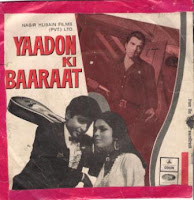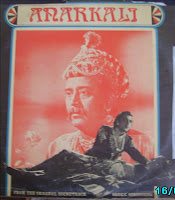
There is yet another singer in Hindi music world, in the Hemant Kumar-Subir Sen mould of singing, with a tinge of the voice of Kishor Kumar. In fact one can discern the nuances of the voice of several noted singers including the pathos typical of Mukesh in his voice. This talented singer is none other than Bhupinder Singh, the ace guitarist and the well known ghazal singer. Bhupinder's voice is considered to be unique and its originality will strike the listener the moment he hears it.
Hailing from Amritsar, he started his career as a guitarist at AIR, Delhi. It was the great music director Madan Mohan who recognised his talent for singing and brought him to Mumbai for a career in films. It was Madan Mohan again who gave him the break in films with the song, 'Hoke Majboor Mujhe usne bhulaya ho' in film Haqueeqat. It was a chorus with Rafi, Talat Mahmood and Balbir. Though the song was an instant hit and very popular, Bhupinder did not get any other offer. It was during this period that he started learning the guitar seriously and became a much sought after guitarist in the Hindi film world. His friendship with R.D.Burman and Gulzar also helped and Bhupinder played guitar in the background for the famous song,'Dum maro dum' in film Hare Rama Hare Krishna. This song became an important milestone of Hindi film music and is hummed by young and old even today. But can anyone think of the song without the unmistakable beats of Bhupinder's guitar in the beginning , in the interludes and in the
music director Madan Mohan who recognised his talent for singing and brought him to Mumbai for a career in films. It was Madan Mohan again who gave him the break in films with the song, 'Hoke Majboor Mujhe usne bhulaya ho' in film Haqueeqat. It was a chorus with Rafi, Talat Mahmood and Balbir. Though the song was an instant hit and very popular, Bhupinder did not get any other offer. It was during this period that he started learning the guitar seriously and became a much sought after guitarist in the Hindi film world. His friendship with R.D.Burman and Gulzar also helped and Bhupinder played guitar in the background for the famous song,'Dum maro dum' in film Hare Rama Hare Krishna. This song became an important milestone of Hindi film music and is hummed by young and old even today. But can anyone think of the song without the unmistakable beats of Bhupinder's guitar in the beginning , in the interludes and in the  background?
background?
Soon he became an integral part of R.D.Burman's team. His guitar was prominently heard in the song, 'Churaliya hai tum ne', in film Yadon ki Baarat pictured on actor Tariq playing guitar in the scene. Again in film Sholay under the baton of R.D., Bhupinder's guitar created magic for the song,' Mehbooba Mehbooba'. Other music directors like Naushad, Lakshmikant Pyarelal, kalyanji Aanandji etc also used his guitar for their songs. In Pakheezah, there is the title music and the song 'Chalte Chalte' to show Bhupinder's prowess with the guitar.
But it was his voice that R.D.Burman wanted to immortalise and that he did with his film, Parichay with the duet with Lata, 'Betina bitai raina' (lyrics by Gulzar) and the song is still a rage for melody lovers. The song made listeners to sit up and listen to the rich, soulful voice of Bhupinder. In Gulzar's own production, Kinara, R.D.Burman tuned Gulazar's lyrics to give a few beautiful songs to Bhupinder, a solo,'Koi nahin hain kaha', a duet with Lata, 'Nam gum jayega' and a pleasant solo,'Ek hi khwab' with a few words and enchanting laugh by Hema Malini.

Other music directors also started using Bhupinder's voice the notable being Jaidev in film Gharonda. The haunting melody,'Ek Akele is shahar mein' and the duet with Runa Laila, 'Do diwane shahar mein' were beautiful for their originality. In film Baazar, the great Khaiyyam gave the melodious song ,'Karoage yaad ki' and in Akhri khat and Thodisi Bewafa he again gave two outstanding songs to Bhupinder. Again who can forget the pathos filled; 'Kisi nazar ko tera' for music director Bappi Lahri in film Aithbar? That also reminds me of the rare ghazal he rendered for M.T.Vasudevan Nair's Malayalam film, Manju. The song is 'Raziaman' penned by Gulzar and composed by the highly respected music director M.B.Sreenivasan



It was again Madan Mohan who brought the best out of Bhupinder in the duet with Lata, in film Mausam, 'Dil dhoondtha hai'. The unique quality and the originality of his voice are well revealed in the song .
.

By then the eclipse of music directors like Madan Mohan, Khaiyyam, Jaidev and a few others had started and RD himself, though the leading composer, appeared to be under compulsion to use the voice of Kishor. Bhupinder found himself being slowly alienated from the field of playback singing in spite of singing hit songs for leading music directors and he decided to fade away as the offers he still received were not to his satisfaction.
Faced with this unenviable situation, he turned his attention to singing ghazals composed by himself as well as others along with his singer wife Mithali. The loss to film music became the boon of ghazal lovers. He came out with several ghazal albums,viz., Mohabat, Ek Hasin Shaam, Kuch Intezar hai, Shabnam, From Bhupinder with Love etc. In the ghazals composed by himself he gave them a classical touch and deviating from tradition, used guitar also to complement his golden voice to make his ghazals unique and highly pleasing. The success he achieved continues to the delight of his innumerable fans.
Tail piece: There is again a rare Hindustani ghazal in a Malayalam film, MEGHA MALHAR. The song penned by Nazeem Akthar and composed by Anup Jhalota was sung by Jithesh, hailing from this place, Tellicherry(Kerala), and well known in the world of Hindustani ghazals.
"Rangath teri zulfon ki' Ps.Please click on he photos to zoom them.
Ps.Please click on he photos to zoom them.
 music director Madan Mohan who recognised his talent for singing and brought him to Mumbai for a career in films. It was Madan Mohan again who gave him the break in films with the song, 'Hoke Majboor Mujhe usne bhulaya ho' in film Haqueeqat. It was a chorus with Rafi, Talat Mahmood and Balbir. Though the song was an instant hit and very popular, Bhupinder did not get any other offer. It was during this period that he started learning the guitar seriously and became a much sought after guitarist in the Hindi film world. His friendship with R.D.Burman and Gulzar also helped and Bhupinder played guitar in the background for the famous song,'Dum maro dum' in film Hare Rama Hare Krishna. This song became an important milestone of Hindi film music and is hummed by young and old even today. But can anyone think of the song without the unmistakable beats of Bhupinder's guitar in the beginning , in the interludes and in the
music director Madan Mohan who recognised his talent for singing and brought him to Mumbai for a career in films. It was Madan Mohan again who gave him the break in films with the song, 'Hoke Majboor Mujhe usne bhulaya ho' in film Haqueeqat. It was a chorus with Rafi, Talat Mahmood and Balbir. Though the song was an instant hit and very popular, Bhupinder did not get any other offer. It was during this period that he started learning the guitar seriously and became a much sought after guitarist in the Hindi film world. His friendship with R.D.Burman and Gulzar also helped and Bhupinder played guitar in the background for the famous song,'Dum maro dum' in film Hare Rama Hare Krishna. This song became an important milestone of Hindi film music and is hummed by young and old even today. But can anyone think of the song without the unmistakable beats of Bhupinder's guitar in the beginning , in the interludes and in the  background?
background?Soon he became an integral part of R.D.Burman's team. His guitar was prominently heard in the song, 'Churaliya hai tum ne', in film Yadon ki Baarat pictured on actor Tariq playing guitar in the scene. Again in film Sholay under the baton of R.D., Bhupinder's guitar created magic for the song,' Mehbooba Mehbooba'. Other music directors like Naushad, Lakshmikant Pyarelal, kalyanji Aanandji etc also used his guitar for their songs. In Pakheezah, there is the title music and the song 'Chalte Chalte' to show Bhupinder's prowess with the guitar.
But it was his voice that R.D.Burman wanted to immortalise and that he did with his film, Parichay with the duet with Lata, 'Betina bitai raina' (lyrics by Gulzar) and the song is still a rage for melody lovers. The song made listeners to sit up and listen to the rich, soulful voice of Bhupinder. In Gulzar's own production, Kinara, R.D.Burman tuned Gulazar's lyrics to give a few beautiful songs to Bhupinder, a solo,'Koi nahin hain kaha', a duet with Lata, 'Nam gum jayega' and a pleasant solo,'Ek hi khwab' with a few words and enchanting laugh by Hema Malini.

Other music directors also started using Bhupinder's voice the notable being Jaidev in film Gharonda. The haunting melody,'Ek Akele is shahar mein' and the duet with Runa Laila, 'Do diwane shahar mein' were beautiful for their originality. In film Baazar, the great Khaiyyam gave the melodious song ,'Karoage yaad ki' and in Akhri khat and Thodisi Bewafa he again gave two outstanding songs to Bhupinder. Again who can forget the pathos filled; 'Kisi nazar ko tera' for music director Bappi Lahri in film Aithbar? That also reminds me of the rare ghazal he rendered for M.T.Vasudevan Nair's Malayalam film, Manju. The song is 'Raziaman' penned by Gulzar and composed by the highly respected music director M.B.Sreenivasan



It was again Madan Mohan who brought the best out of Bhupinder in the duet with Lata, in film Mausam, 'Dil dhoondtha hai'. The unique quality and the originality of his voice are well revealed in the song
 .
.
By then the eclipse of music directors like Madan Mohan, Khaiyyam, Jaidev and a few others had started and RD himself, though the leading composer, appeared to be under compulsion to use the voice of Kishor. Bhupinder found himself being slowly alienated from the field of playback singing in spite of singing hit songs for leading music directors and he decided to fade away as the offers he still received were not to his satisfaction.
Faced with this unenviable situation, he turned his attention to singing ghazals composed by himself as well as others along with his singer wife Mithali. The loss to film music became the boon of ghazal lovers. He came out with several ghazal albums,viz., Mohabat, Ek Hasin Shaam, Kuch Intezar hai, Shabnam, From Bhupinder with Love etc. In the ghazals composed by himself he gave them a classical touch and deviating from tradition, used guitar also to complement his golden voice to make his ghazals unique and highly pleasing. The success he achieved continues to the delight of his innumerable fans.

Tail piece: There is again a rare Hindustani ghazal in a Malayalam film, MEGHA MALHAR. The song penned by Nazeem Akthar and composed by Anup Jhalota was sung by Jithesh, hailing from this place, Tellicherry(Kerala), and well known in the world of Hindustani ghazals.
"Rangath teri zulfon ki'
 Ps.Please click on he photos to zoom them.
Ps.Please click on he photos to zoom them.





































